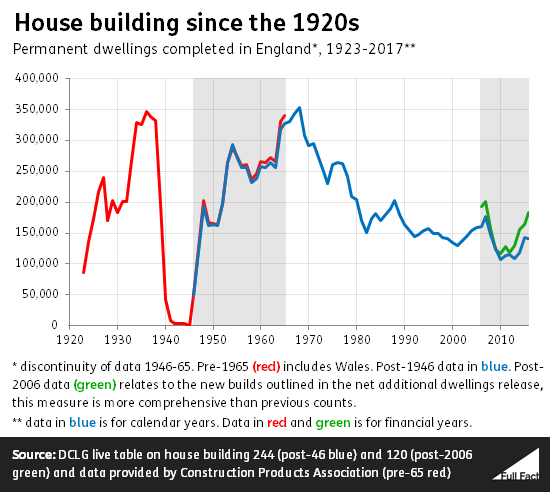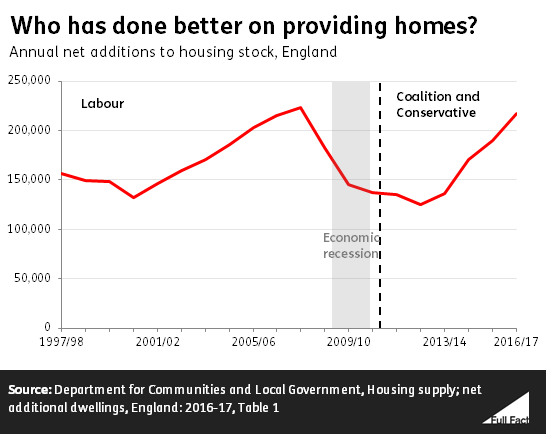House building in England
Housing is devolved to Scotland, Wales and Northern Ireland, so the UK government is only responsible for housing in England.
184,000 homes were completed in England in 2016/17. This is more than in recent years, but still below the 2007/08 pre-recession peak of 200,000.
Taking a long view, house building has been mostly decreasing since the 1960s. The early years of this decade saw house building at its lowest peacetime level since the 1920s.

Join 72,547 people who trust us to check the facts
Subscribe to get weekly updates on politics, immigration, health and more.
There are two different sets of housebuilding figures
The more historical figures are known to have undercounted the number of homes that have been built. Since 2006, there are more accurate figures available, and these are the ones we’re quoting when we say 184,000 homes were built in 2016/17. The older measure shows only 148,000 homes completed in England in 2016/17.
We can also count the number of homes that were started in any given year. In 2016/17 there were 163,000 started. These figures are also thought to undercount the number of homes built, but we don’t have a more complete set of figures on these.
How else can we crunch the numbers?
Sometimes people use figures for across the United Kingdom instead of just England. 178,000 homes were completed in 2016/17, and 197,000 started, although again these use the incomplete figures.
We can also look at how many homes are added to the overall stock each year, rather than just focusing on how many were built.
Using our most complete set of figures there were 217,000 more homes in England in 2016/17 than the year before, including the 184,000 that were built from scratch. This figure also takes into account homes that are converted or are changed to residential use, having previously been something else like an office or agricultural building. It also takes into consideration the number of homes that are demolished over the year.
Who’s done better?
The various ways of mixing and matching the figures and their geographical coverage can make it tricky to compare the records of different governments.
There’s also the matter of when exactly you pick your starting point. Recent elections and changes of government have taken place in May of a given year, so claims about a particular government’s record might measure from the start of that calendar year, the start of that financial year, or the start of the following year.
Similarly, houses completed early in the life of one government will have been started under the previous one, and it can take time before a new housing policy is introduced and has an impact on building.

How many homes do we need?
No recent government has seen enough homes built to keep up with demand.
There are various ways of measuring the ‘housing gap’ between how many we need and how many we’re building. One way is comparing projections for the number of new households with current house building.
England is projected to have 210,000 extra households per year between 2014 and 2039. A household is a person living alone or a group of people living together (such as a family), and two or more households can share one house. We don’t necessarily need one house per new household.
We can compare the projection to the main house building figure of 184,000 in 2016/17 or the 217,000 homes added to the stock that year.
In 2014 Dr Alan Holmans, a housing expert at the University of Cambridge, produced new estimates of the housing gap. They were based on 2011 data but took housing conversions, second homes and vacancies into account.
His analysis suggests that we need to build about 170,000 additional private sector houses and 75,000 social sector houses each year—in total, an extra 240,000-250,000 houses each year, excluding any reductions in the existing housing stock.
Correction 28 April 2017
We changed the title of the graph to reflect the fact it doesn't just include house building. Previously it was titled 'Who has done better on building homes?'
Correction 4 September 2017
We removed a typo and where we had described how many 'houses' were added to the overall stock each year changed this to refer to 'homes'.